CEO SUMMARY: In a refreshingly candid assessment of current technology published in IVD Technology magazine, one lab industry executive describes both the successes and the failings of analyzers, automation, and software. He offers three trends he expects will address the deficiencies of the current generation of products. Help appears to be on the way, even …
IVD Executive Discusses Three Developing Trends Read More »
To access this post, you must purchase The Dark Report.


